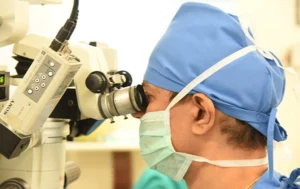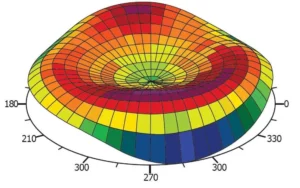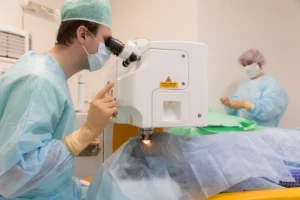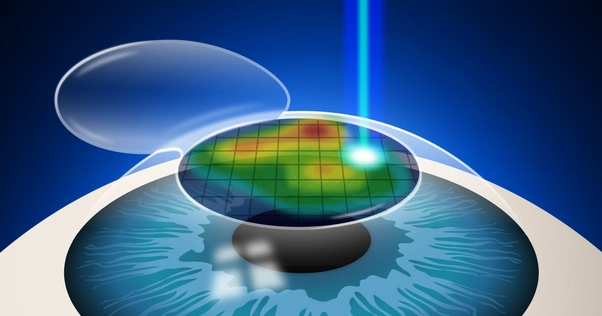When it comes to advanced vision correction techniques, Contoura and Epi-Contoura are two names that often arise. Both procedures aim to enhance visual acuity and reduce the dependency on glasses or contact lenses. However, understanding the differences between the two is essential in making an informed decision. In this blog, we delve into the intricacies of these cutting-edge techniques, exploring their unique features, benefits, and considerations.
Contents
What Are Contoura & EPI Contopura?
 The surgeries are advanced vision correction techniques that have gained significant attention in the field of refractive surgery. These procedures aim to provide precise and personalized treatment for individuals seeking improved vision and reduced reliance on glasses or contact lenses.
The surgeries are advanced vision correction techniques that have gained significant attention in the field of refractive surgery. These procedures aim to provide precise and personalized treatment for individuals seeking improved vision and reduced reliance on glasses or contact lenses.
Here are some key points that define the procedures a bit deeper:
- Personalized Vision Correction: the surgeries utilize advanced technology to create personalized treatment plans, tailoring the procedure to the individual’s unique corneal characteristics.
- Corneal Topography: Both techniques rely on corneal topography, a detailed mapping of the cornea’s shape and curvature, to guide the surgical process and optimize vision correction.
- Contoura: Contoura, also known as topography-guided LASIK, utilizes the corneal topography data to precisely reshape the cornea, correcting irregularities and improving visual acuity.
- EPI Contoura: EPI Contoura, or epithelial thickness profile-guided treatment, combines corneal topography with a comprehensive analysis of the corneal epithelium’s thickness. It aims to optimize the ablation pattern for enhanced visual outcomes.
- Wavefront Analysis: Both techniques incorporate wavefront analysis to measure and correct higher-order aberrations, addressing subtle imperfections in the optical system of the eye.
- Considerations for Candidacy: Factors such as corneal thickness, stability of refraction, and the presence of certain eye conditions influence the eligibility for both procedures.
By exploring the features and considerations of both surgeries, individuals can gain valuable insights into these advanced vision correction techniques and make informed decisions about their vision correction journey.
Dissimilarity Between Contoura EPI Contoura?
 These surgeries are two distinct vision correction techniques with some key differences:
These surgeries are two distinct vision correction techniques with some key differences:
- Methodology: Contoura is a topography-guided LASIK procedure that utilizes corneal topography data to reshape the cornea and correct irregularities. EPI Contoura, on the other hand, is an epithelial thickness profile-guided treatment that combines corneal topography with an analysis of the corneal epithelium’s thickness to optimize the ablation pattern.
- Corneal Layer Consideration: Contoura focuses on reshaping the stromal layer of the cornea, which is the thicker underlying tissue. EPI Contoura additionally considers the epithelial layer, which is the thin outermost layer of the cornea. While optimizing treatment based on its thickness profile.
- Personalization: Both techniques offer personalized treatment plans based on individual corneal characteristics. But EPI Contoura takes it a step further by considering the corneal epithelial thickness profile in addition to corneal topography.
- Eligibility: The eligibility criteria for both may differ based on factors such as corneal thickness. Along with stability of refraction, and the presence of specific eye conditions. A thorough consultation and evaluation by an eye care professional are necessary to determine candidacy for each procedure.
Understanding these differences can help individuals make informed decisions regarding their vision correction options, considering factors such as visual goals, corneal characteristics, and overall visual quality preferences. Consulting with an experienced eye care professional is crucial in determining the most suitable technique for individual needs.
Is Epi Contoura Safe?
 Epi Contoura, also known as Epi-LASIK with Contoura, is a laser refractive surgery that combines the benefits of Contoura Vision technology with the Epi-LASIK technique. While the safety of any surgical procedure carries some inherent risks, Epi Contoura is generally considered safe and effective.
Epi Contoura, also known as Epi-LASIK with Contoura, is a laser refractive surgery that combines the benefits of Contoura Vision technology with the Epi-LASIK technique. While the safety of any surgical procedure carries some inherent risks, Epi Contoura is generally considered safe and effective.
Here are a few crucial points regarding the safety of Epi Contoura:
- Minimally invasive: Epi Contoura is a minimally invasive procedure that does not require the creation of a corneal flap like traditional LASIK. In
- stead, the surgeon uses an epithelial separator to gently lift and remove the thin outer layer of the cornea before reshaping it with an excimer laser.
- Lower risk of complications: Epi Contoura reduces the risk of certain complications associated with traditional LASIK, such as flap-related issues or corneal thickness concerns.
- Recovery period: The recovery after Epi Contoura is similar to other laser vision correction procedures. It typically involves a few days of initial discomfort and blurry vision, followed by a gradual improvement in visual acuity over the following weeks.
Are Contoura & Epi Contoura painless?
Contoura and Epi Contoura procedures are generally considered to be relatively painless. Here are some points regarding the level of pain associated with these surgeries:
- Anesthesia: Both surgeries are performed under local anesthesia, which ensures that the eye is numbed during the procedure. This helps minimize any potential pain or discomfort.
- Patient experience: While individual experiences may vary, most patients report feeling minimal to no pain during the surgeries. Some patients may experience mild discomfort or a sensation of pressure, but this is typically well-tolerated and temporary.
- Pain management: Surgeons may provide pain-relieving eye drops or prescribe medications to alleviate any postoperative discomfort. It is important to follow the prescribed medication regimen and adhere to postoperative care instructions to ensure a comfortable recovery.
While the surgeries are generally considered to be painless, it is essential to keep in mind that pain thresholds vary among individuals. If you have concerns about pain or discomfort during or after the procedure, it is best to discuss them with your eye surgeon beforehand. They can provide you with personalized information based on your specific circumstances and take steps to ensure your comfort throughout the process.
What Is The Success Rate Of Contoura & EPI Contoura
 The success rate of both procedures can be summarized in the following points:
The success rate of both procedures can be summarized in the following points:
- High Success Rate: Both surgeries have demonstrated high success rates around 90-95%. Especially, in improving visual acuity and overall visual quality for eligible candidates.
- Individual Variation: Success rates may vary depending on factors such as pre-existing eye conditions. Along with corneal characteristics, and the expertise of the surgeon performing the procedure.
- Significant Visual Improvements: Clinical studies have shown that both surgeries can lead to significant improvements in visual acuity. Reducing the dependence on glasses or contact lenses for many individuals.
- Addressing Corneal Irregularities: These techniques are particularly effective in correcting corneal irregularities. Resulting in improved vision, reduced distortions, and enhanced visual quality.
- Comprehensive Evaluation: A thorough evaluation by an experienced eye care professional is necessary to determine an individual’s candidacy. Along with providing personalized information regarding the expected success rate.
- Patient Satisfaction: Many individuals who have undergone for both procedures report high levels of satisfaction. Along with the outcomes, experiencing improved vision and enhanced quality of life.
It is important to consult with an eye care professional for a comprehensive assessment. Along with personalized information regarding the expected success rate based on individual circumstances.
Conclusion
In conclusion, both procedures are advanced vision correction techniques. Both offer significant advantages for individuals seeking improved visual acuity and reduced dependence on glasses or contact lenses. Contoura utilizes topography-guided LASIK to precisely reshape the cornea and correct irregularities. While EPI Contoura combines corneal topography with an analysis of the epithelial thickness profile for optimized treatment. These procedures provide personalized treatment plans based on individual corneal characteristics, leading to enhanced overall visual quality.
Lasik surgery is a safe 10-minute procedure to help you get rid of glasses. EyeMantra offers the most advanced LASIK options including PRK, Femto Lasik, SMILE surgery, Standard LASIK, ICL, and Contoura vision. If you have any questions on Lasik surgery in Delhi, Lasik surgery cost, and Lasik procedure, call us at 9711116605 or email at [email protected].



Way cool! Some very vakid points! I appreciate you penning this
write-up and tthe rest of the wewbsite is very good. https://Waste-ndc.pro/community/profile/tressa79906983/